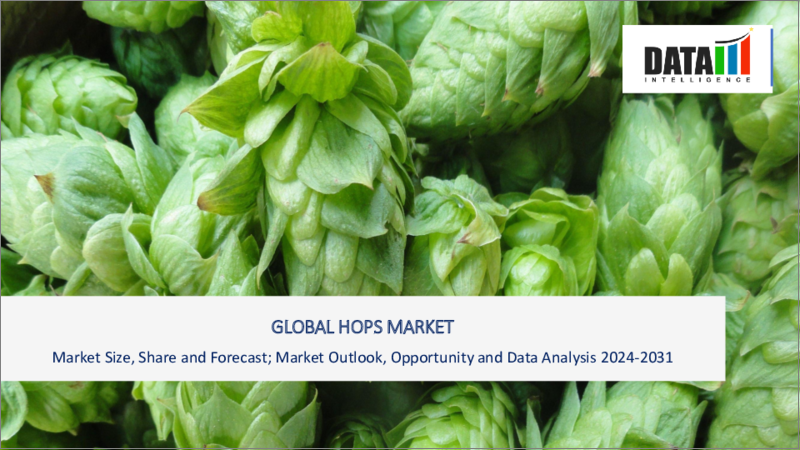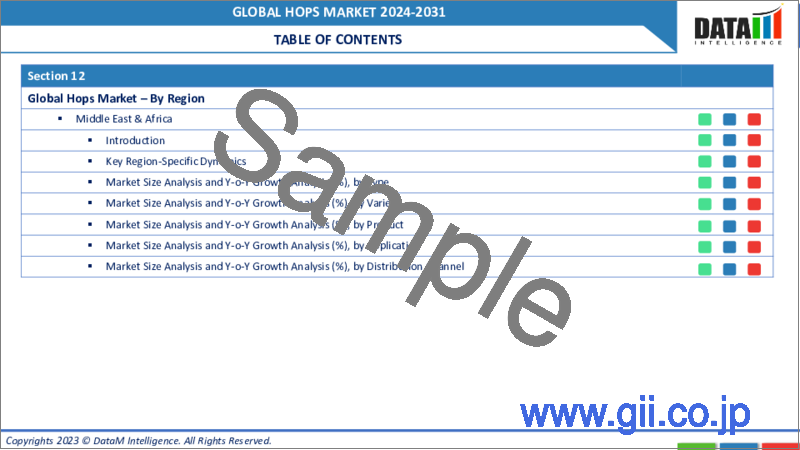|
|
市場調査レポート
商品コード
1336758
ホップの世界市場-2023年~2030年Global Hops Market - 2023-2030 |
||||||
カスタマイズ可能
適宜更新あり
|
|||||||
| ホップの世界市場-2023年~2030年 |
|
出版日: 2023年08月22日
発行: DataM Intelligence
ページ情報: 英文 189 Pages
納期: 即日から翌営業日
|
- 全表示
- 概要
- 目次
概要
世界のホップ市場は2022年に78億米ドルに達し、2023-2030年の予測期間中にCAGR 6.8%で成長し、2030年には133億米ドルに達すると予測されています。
ホップはHumulus lupulusという植物の花です。ホップはビールの鮮度を長時間保つために使用されます。ホップはビールの泡の保持を助け、ビールの香り、風味、苦味の重要な構成要素です。ホップは、現在市販されているビールの大半に含まれています。
ビール消費に対する世界の需要の高まりが、ホップ市場の拡大を後押ししています。現在のクラフトビール業界の動向は、ホップへの依存度の高まりと同様に成長しています。さらに、Bart Watson氏によると、米国のビールメーカーは2020年までにさらに2,400万ポンドのホップ(主にアロマ)を必要とします。ビールメーカーによるホップ需要は、予測期間中の市場拡大を促進すると思われます。
市場力学
醸造手順におけるホップの採用拡大
ホップは、酵母や穀物よりもむしろ、醸造作業製品において最も重要な成分です。ビール製造に必要な成分はほとんどありません。実際、ドイツのビール純度法では、ビールは水、ホップ、大麦(麦芽)、酵母のみで製造することが義務付けられています。ホップの醸造上の価値は、ホップコーンのルプリン腺に含まれる樹脂と油によって生み出される独特の風味と香りにあります。醸造所は、苦味付け(高いアルファ酸レベル)、仕上げ(高いアロマレベル)、デュアル(両方の混合)など、様々な目的でホップを使用します。
さらに、IPAに見られるように、ホップの香りの人気が高まるにつれて、より多くの醸造所がアロマホップを多量に使用し、醸造サイクルのさまざまな時点で添加するようになっています。USA HOPSによると、アンバーなどの異なるスタイルのビールに使用されるホップの量は、1kgあたりおよそ0.17ポンド、バーレイワイン1.57ポンド、インペリアルIPA3.8ポンド、インペリアルスタウト1.73ポンドとなっています。
化粧品業界における需要の増加(抗酸化特性別)
ホップは、その苦味と芳香特性のために醸造プロセスで一般的に利用されていますが、他の用途でも使用されています。美容分野での様々なホップの使用増加も市場を牽引しています。ホップにはキサントフモールやフムレンと呼ばれる化学物質が含まれており、抗炎症作用があります。
ホップはその特質から、ローション、クリーム、美容液などのスキンケア製品に最適な成分です。例えば、2021年8月24日、キリンホールディングス株式会社と株式会社ファンケルは共同で、熟成ホップエキスが化粧品原料に変化した後、皮膚の毛穴の状態を高めるという新しい機能を持つことを発見しました。
さらに、ホップは抗酸化物質やポリフェノールを多く含むため鎮静作用があり、敏感な目元に理想的な成分です。例えば、スウェーデンの化粧品会社であるoriflame Cosmetics AGは、特にあらゆる肌タイプに潤いと栄養を与えるために開発され、ホップを配合したHydra Radiance Eye Creamを提供しています。
長い妊娠期間
ホップは多年草であり、完熟して収穫できるようになるまでには長い妊娠期間が必要です。新しく植えられたホップ畑では、根がしっかりと張り、収穫できるようになるまで通常2~3年かかります。この間、ホップは労働力、水、その他の資源を大量に投入する必要がありますが、すぐに結果が出るわけではありません。
さらに、ホップは様々な肥料や水を必要とし、それらを周期的に散布しなければなりません。妊娠期間が長いため、栽培の最初の数年間は供給が制限されることもあります。醸造業者やその他のホップ消費者は、供給が制限された結果、時折欠品に見舞われることがあります。妊娠期間が長いため、ホップ生産者は数年先の市場需要を正確に予測するのに苦労します。
COVID-19影響分析
ホップ産業はパブの閉鎖により崩壊の危機にあります。ホップ生産業界は、数ヶ月に及ぶパブ閉鎖の結果、COVID-19の影響でビールメーカーが来年産のホップを買いたがらなくなり、崩壊の危機に瀕しています。業界団体によると、2021年産の40%しか醸造業者と契約しておらず、パンデミックによる消費激減で今年は余剰となっています。
さらに、米国のクラフト飲料業界は、COVID-19パンデミックの結果、かつてない成長を遂げています。全米世論調査によると、クラフトビールメーカーの22%以上がパンデミックを乗り切れず、工場の永久閉鎖を余儀なくされます。2020年3月25日現在、米国で発生したコロナウイルスへの対応について世論調査を行った醸造所の大半は、醸造所の操業を停止していません。65%以上の醸造所が生産を減速し、30%以上が完全に生産を停止しました。
目次
第1章 調査手法と調査範囲
第2章 定義と概要
第3章 エグゼクティブサマリー
第4章 市場力学
- 影響要因
- 促進要因
- 醸造用ホップの採用拡大
- 抗酸化特性に関連した化粧品業界における需要の増加
- 広い応用範囲
- クラフトビールが苦味ホップの需要を牽引している
- 抑制要因
- 長い熟成期間
- 規制と貿易上の制約
- 機会
- 影響分析
- 促進要因
第5章 産業分析
- ポーターのファイブフォース分析
- サプライチェーン分析
- 価格分析
- 規制分析
第6章 COVID-19分析
第7章 タイプ別
- 苦味ホップ
- アロマホップ
- デュアルホップ
第8章 品種別
- カスケード
- シトラ
- モザイク
- マグナム
- アマリロ
- センテニアル
- その他
第9章 製品別
- 有機(生)ホップ
- 有機エキス
- 無機エキス
第10章 流通チャネル別
- eコマース
- 専門店
- スーパーマーケット/ハイパーマーケット
- その他
第11章 用途別
- アルコール飲料
- ビール
- 蜂蜜酒
- サイダー
- その他
- 化粧品
- 医薬品
- その他
第12章 地域別
- 北米
- 米国
- カナダ
- メキシコ
- 欧州
- ドイツ
- 英国
- フランス
- イタリア
- ロシア
- その他欧州
- 南米
- ブラジル
- アルゼンチン
- その他南米
- アジア太平洋
- 中国
- インド
- 日本
- オーストラリア
- その他アジア太平洋
- 中東・アフリカ
第13章 競合情勢
- 競合シナリオ
- 市況/シェア分析
- M&A分析
第14章 企業プロファイル
- Roy Farms Inc.
- 会社概要
- 製品ポートフォリオと説明
- 財務概要
- 最近の動向
- Barth-Haas Group
- Hops Direct, LLC.
- HOP HEAD FARMS
- Clayton Hops NZ
- Charles Faram
- NZ Hops Ltd
- Crosby Hop Farm, LLC
- Yakima Valley Hops
- Hopsteiner
第15章 会社概要付録
Overview
Global Hops Market reached US$ 7.8 billion in 2022 and is expected to reach US$ 13.3 billion by 2030, growing with a CAGR of 6.8% during the forecast period 2023-2030.
Hops are the flowers of the Humulus lupulus plant. Hops are used to keep beer fresher for extended periods of time. It aids in the retention of a beer's head of foam and is an important component of a beer's aroma, flavor and bitterness. In addtion, hops are included in the majority of beers on the market today.
The growing global demand for beer consumption drives the expansion of the hops market. The present growing trends in the craft beer industry, as well as the increased reliance on hops. Furthermore, according to Bart Watson, US brewers will require an additional 24 million pounds of hops (mainly aroma) by 2020. The demand for hops by brewers will fuel market expansion over the projected period.
Market Dynamics
Growing Adoption of Hops for Brewing Procedures
Hops, rather than yeast or grain, is the most important component in brewing operations products. Few components are required for beer manufacturing. In reality, the German beer purity legislation mandates that beer be manufactured solely from water, hops, barley (malt) and yeast. Hops' brewing worth is found in the distinct flavors and fragrances produced by resins and oils contained inside the lupulin glands of hop cones. Breweries employ hops for a variety of purposes, including bittering (high alpha acid levels), finishing (high aroma levels) and dual (a mixture of both).
Furthermore, as the popularity of hop scents grows, as seen in an IPA, more breweries are employing higher amounts of aroma hops and adding them at different points of the brewing cycle. According to USA HOPS, the amount of hops used for different beer styles such as amber is roughly 0.17 lb per kg, barleywine 1.57lb hops, Imperial IPA 3.8lb hops per kg and imperial stout 1.73lb hops used per kg.
Increasing Demand in Cosmetics Industry Associated With Antioxidant Properties
Hops are commonly utilized in the brewing process due to their bitter and aromatic properties, but they are also employed in other applications. The rising use of various hops in the beauty sector is also driving the market. Hops include chemicals known as xanthohumol and humulene, which have anti-inflammatory properties.
Hops are a great component in skin care products such as lotions, creams and serums because of their qualities. For instance, on August 24, 2021, Kirin Holdings Company, Limited and FANCL Corporation jointly discovered that Matured Hop Extract has a novel function of enhancing the condition of skin pores after transforming it into a raw material for cosmetics.
Furthermore, hops have soothing properties due to their high level of antioxidants and polyphenols, making them an ideal ingredient for the sensitive eye region. For example oriflame Cosmetics AG, a Swedish cosmetic firm, provides its Hydra Radiance Eye Cream, which is particularly developed to hydrate and nourish all skin types and contains hops.
Long Gestation Period
Hops are perennial plants with a long gestation period before reaching full maturity and output. Newly planted hop fields generally take two to three years to establish robust root systems and generate a harvestable output. During this time, the hop plants need considerable inputs in labour, water and other resources that do not yield immediate results.
Furthermore, hops require a variety of fertilisers and water, which must be applied in a cyclical pattern. Because of the extended gestation time, supplies may be limited during the first years of cultivation. Brewers and other hops consumers may encounter occasional shortages as a result of the restricted supply. Because of the long gestation period, hop producers struggle to precisely estimate market demand years in advance.
COVID-19 Impact Analysis
The hop industry is in a crisis of collapsing as a result of pub closures. The hop-growing industry is at risk of collapsing after the months-long closure of pubs during the lockdown made brewers unwilling to buy next year's crop due to COVID-19. According to the Trade Groups, only 40% of the 2021 crop has been contracted to brewers, who have a surplus this year due to a sharp drop in consumption due to the pandemic.
Furthermore, the craft beverage industry in the United States has experienced unprecedented growth as a result of the COVID-19 pandemic. According to a national poll, more than 22% of craft brewers will not survive the pandemic, forcing their plants to close permanently. As of March 25, 2020, the majority of breweries polled about their production scheduling response to the coronavirus outbreak in the United States had not ceased brewery operations. Over 65 percent of breweries had slowed production and more than 30 percent had completely ceased production.
Segment Analysis
The global hops market is segmented based on type, variety, product, distribution channel, application and region.
The Use of Hops in Alcoholic Beverages is Expected to Increase Rapidly
Consumers are becoming more intrest to new flavors and innovations as their interest in health and well-being and the use of natural and organic products grows. Beverage manufacturers have used a variety of methods and ingredients to bring these hops products to market and experts remark that hops are offering a solution for beverages in a variety of categories.
The most crucial part of any beverage drink is the flavor. With millennials driving the need for novel flavors, beverage manufacturers have begun to use hops and malts to produce distinctive flavors and innovations. Furthermore, the bitterness given by hops is an emerging flavor trend. Furthermore, IPA is the most popular type of craft beer. According to USA HOPS, the Imperial IPA uses 3.8lb of hops per kilogram. Furthermore, the United States beer sales volume 182.05 billion BBLS in 2022, with craft beer accounting for 13.2% of the total with a volume of 24.04 billion BBLS reported by Breweres Association.
Geographical Analysis
Europe is the Most Rapidly Expanding Market
In 2022, Europe was the fastest-growing market for hops, owing to increased imports as well as an increase in hop cultivation areas, driven by increasing demand for beer. After the United States, Germany is the world's second-largest hop-growing country, with hops grown on an area of approximately 20,144 hectares (roughly the size of 50,000 football fields) across the country.
According to the International Trade Centre, the United Kingdom, France, Spain and Germany will import a total of 1,279, 684 and 631 metric tonnes of hops in 2021, respectively. Furthermore, Europe is the world's largest beer-consuming region, with the Czech Republic leading the way with 143.3 liters per capita, followed by Germany with 104.2 liters per capita, Poland with 100.8 liters per capita, Ireland with 98.2 liters per capita and others.
Competitive Landscape
The major global players include: Roy Farms Inc., Barth-Haas Group, Hops Direct, LLC., HOP HEAD FARMS, Clayton Hops NZ, Charles Faram, NZ Hops Ltd, Crosby Hop Farm, LLC, Yakima Valley Hops and Hopsteiner
Why Purchase the Report?
- To visualize the global hops market segmentation based on type, variety, product, distribution channel, application and region, as well as understand key commercial assets and players.
- Identify commercial opportunities by analyzing trends and co-development.
- Excel data sheet with numerous data points of hops market-level with all segments.
- PDF report consists of a comprehensive analysis after exhaustive qualitative interviews and an in-depth study.
- Product mapping available as Excel consisting of key products of all the major players.
The global hops market report would provide approximately 77 tables, 83 figures and 189 Pages.
Target Audience 2023
- Manufacturers/ Buyers
- Industry Investors/Investment Bankers
- Research Professionals
- Emerging Companies
Table of Contents
1. Methodology and Scope
- 1.1. Research Methodology
- 1.2. Research Objective and Scope of the Report
2. Definition and Overview
3. Executive Summary
- 3.1. Snippet by Type
- 3.2. Snippet by Variety
- 3.3. Snippet by Product
- 3.4. Snippet by Distribution Channel
- 3.5. Snippet by Application
- 3.6. Snippet by Region
4. Dynamics
- 4.1. Impacting Factors
- 4.1.1. Drivers
- 4.1.1.1. Growing Adoption of Hops for Brewing Procedures
- 4.1.1.2. Increasing Demand in Cosmetics Industry Associated With Antioxidant Properties
- 4.1.1.3. Wide Application Area
- 4.1.1.4. Craft Beer is Driving Demand for Bittering Hops
- 4.1.2. Restraints
- 4.1.2.1. Long Gestation Period
- 4.1.2.2. Regulatory and Trade Constraints
- 4.1.3. Opportunity
- 4.1.4. Impact Analysis
- 4.1.1. Drivers
5. Industry Analysis
- 5.1. Porter's Five Force Analysis
- 5.2. Supply Chain Analysis
- 5.3. Pricing Analysis
- 5.4. Regulatory Analysis
6. COVID-19 Analysis
- 6.1. Analysis of COVID-19
- 6.1.1. Scenario Before COVID
- 6.1.2. Scenario During COVID
- 6.1.3. Scenario Post COVID
- 6.2. Pricing Dynamics Amid COVID-19
- 6.3. Demand-Supply Spectrum
- 6.4. Government Initiatives Related to the Market During Pandemic
- 6.5. Manufacturers Strategic Initiatives
- 6.6. Conclusion
7. By Type
- 7.1. Introduction
- 7.1.1. Market Size Analysis and Y-o-Y Growth Analysis (%), By Type
- 7.1.2. Market Attractiveness Index, By Type
- 7.2. Bittering Hops*
- 7.2.1. Introduction
- 7.2.2. Market Size Analysis and Y-o-Y Growth Analysis (%)
- 7.3. Aroma Hops
- 7.4. Dual Hops
8. By Variety
- 8.1. Introduction
- 8.1.1. Market Size Analysis and Y-o-Y Growth Analysis (%), By Variety
- 8.1.2. Market Attractiveness Index, By Variety
- 8.2. Cascade*
- 8.2.1. Introduction
- 8.2.2. Market Size Analysis and Y-o-Y Growth Analysis (%)
- 8.3. Citra
- 8.4. Mosaic
- 8.5. Magnum
- 8.6. Amarillo
- 8.7. Centennial
- 8.8. Others
9. By Product
- 9.1. Introduction
- 9.1.1. Market Size Analysis and Y-o-Y Growth Analysis (%), By Product
- 9.1.2. Market Attractiveness Index, By Product
- 9.2. Organic (Raw) hops*
- 9.2.1. Introduction
- 9.2.2. Market Size Analysis and Y-o-Y Growth Analysis (%)
- 9.3. Organic Extracts
- 9.4. Inorganic Extracts
10. By Distribution Channel
- 10.1. Introduction
- 10.1.1. Market Size Analysis and Y-o-Y Growth Analysis (%), By Distribution Channel
- 10.1.2. Market Attractiveness Index, By Distribution Channel
- 10.2. E-Commerce*
- 10.2.1. Introduction
- 10.2.2. Market Size Analysis and Y-o-Y Growth Analysis (%)
- 10.3. Specialty Stores
- 10.4. Supermarket/Hypermarket
- 10.5. Others
11. By Application
- 11.1. Introduction
- 11.1.1. Market Size Analysis and Y-o-Y Growth Analysis (%), By Application
- 11.1.2. Market Attractiveness Index, By Application
- 11.2. Alcoholic beverages*
- 11.2.1. Introduction
- 11.2.2. Market Size Analysis and Y-o-Y Growth Analysis (%)
- 11.2.3. Beer
- 11.2.4. Mead
- 11.2.5. Cider
- 11.2.6. Others
- 11.3. Cosmetics
- 11.4. Pharmaceuticals
- 11.5. Others
12. By Region
- 12.1. Introduction
- 12.1.1. Market Size Analysis and Y-o-Y Growth Analysis (%), By Region
- 12.1.2. Market Attractiveness Index, By Region
- 12.2. North America
- 12.2.1. Introduction
- 12.2.2. Key Region-Specific Dynamics
- 12.2.3. Market Size Analysis and Y-o-Y Growth Analysis (%), By Type
- 12.2.4. Market Size Analysis and Y-o-Y Growth Analysis (%), By Variety
- 12.2.5. Market Size Analysis and Y-o-Y Growth Analysis (%), By Product
- 12.2.6. Market Size Analysis and Y-o-Y Growth Analysis (%), By Distribution Channel
- 12.2.7. Market Size Analysis and Y-o-Y Growth Analysis (%), By Application
- 12.2.8. Market Size Analysis and Y-o-Y Growth Analysis (%), By Country
- 12.2.8.1. U.S.
- 12.2.8.2. Canada
- 12.2.8.3. Mexico
- 12.3. Europe
- 12.3.1. Introduction
- 12.3.2. Key Region-Specific Dynamics
- 12.3.3. Market Size Analysis and Y-o-Y Growth Analysis (%), By Type
- 12.3.4. Market Size Analysis and Y-o-Y Growth Analysis (%), By Variety
- 12.3.5. Market Size Analysis and Y-o-Y Growth Analysis (%), By Product
- 12.3.6. Market Size Analysis and Y-o-Y Growth Analysis (%), By Distribution Channel
- 12.3.7. Market Size Analysis and Y-o-Y Growth Analysis (%), By Application
- 12.3.8. Market Size Analysis and Y-o-Y Growth Analysis (%), By Country
- 12.3.8.1. Germany
- 12.3.8.2. UK
- 12.3.8.3. France
- 12.3.8.4. Italy
- 12.3.8.5. Russia
- 12.3.8.6. Rest of Europe
- 12.4. South America
- 12.4.1. Introduction
- 12.4.2. Key Region-Specific Dynamics
- 12.4.3. Market Size Analysis and Y-o-Y Growth Analysis (%), By Type
- 12.4.4. Market Size Analysis and Y-o-Y Growth Analysis (%), By Variety
- 12.4.5. Market Size Analysis and Y-o-Y Growth Analysis (%), By Product
- 12.4.6. Market Size Analysis and Y-o-Y Growth Analysis (%), By Distribution Channel
- 12.4.7. Market Size Analysis and Y-o-Y Growth Analysis (%), By Application
- 12.4.8. Market Size Analysis and Y-o-Y Growth Analysis (%), By Country
- 12.4.8.1. Brazil
- 12.4.8.2. Argentina
- 12.4.8.3. Rest of South America
- 12.5. Asia-Pacific
- 12.5.1. Introduction
- 12.5.2. Key Region-Specific Dynamics
- 12.5.3. Market Size Analysis and Y-o-Y Growth Analysis (%), By Type
- 12.5.4. Market Size Analysis and Y-o-Y Growth Analysis (%), By Variety
- 12.5.5. Market Size Analysis and Y-o-Y Growth Analysis (%), By Product
- 12.5.6. Market Size Analysis and Y-o-Y Growth Analysis (%), By Distribution Channel
- 12.5.7. Market Size Analysis and Y-o-Y Growth Analysis (%), By Application
- 12.5.8. Market Size Analysis and Y-o-Y Growth Analysis (%), By Country
- 12.5.8.1. China
- 12.5.8.2. India
- 12.5.8.3. Japan
- 12.5.8.4. Australia
- 12.5.8.5. Rest of Asia-Pacific
- 12.6. Middle East and Africa
- 12.6.1. Introduction
- 12.6.2. Key Region-Specific Dynamics
- 12.6.3. Market Size Analysis and Y-o-Y Growth Analysis (%), By Type
- 12.6.4. Market Size Analysis and Y-o-Y Growth Analysis (%), By Variety
- 12.6.5. Market Size Analysis and Y-o-Y Growth Analysis (%), By Product
- 12.6.6. Market Size Analysis and Y-o-Y Growth Analysis (%), By Distribution Channel
- 12.6.7. Market Size Analysis and Y-o-Y Growth Analysis (%), By Application
- 12.6.8. Market Size Analysis and Y-o-Y Growth Analysis (%), By Application
13. Competitive Landscape
- 13.1. Competitive Scenario
- 13.2. Market Positioning/Share Analysis
- 13.3. Mergers and Acquisitions Analysis
14. Company Profiles
- 14.1. Roy Farms Inc.*
- 14.1.1. Company Overview
- 14.1.2. Product Portfolio and Description
- 14.1.3. Financial Overview
- 14.1.4. Recent Developments
- 14.2. Barth-Haas Group
- 14.3. Hops Direct, LLC.
- 14.4. HOP HEAD FARMS
- 14.5. Clayton Hops NZ
- 14.6. Charles Faram
- 14.7. NZ Hops Ltd
- 14.8. Crosby Hop Farm, LLC
- 14.9. Yakima Valley Hops
- 14.10. Hopsteiner
LIST NOT EXHAUSTIVE
15. Appendix
- 15.1. About Us and Services
- 15.2. Contact Us






